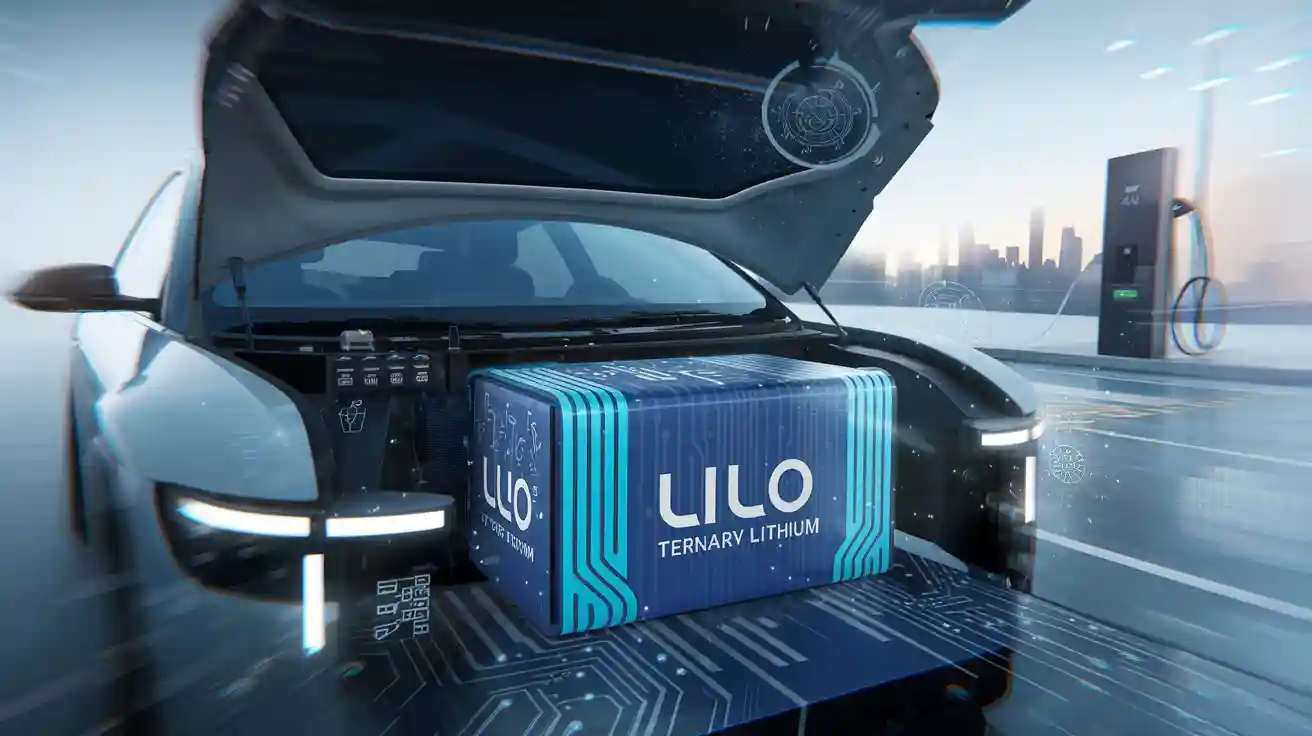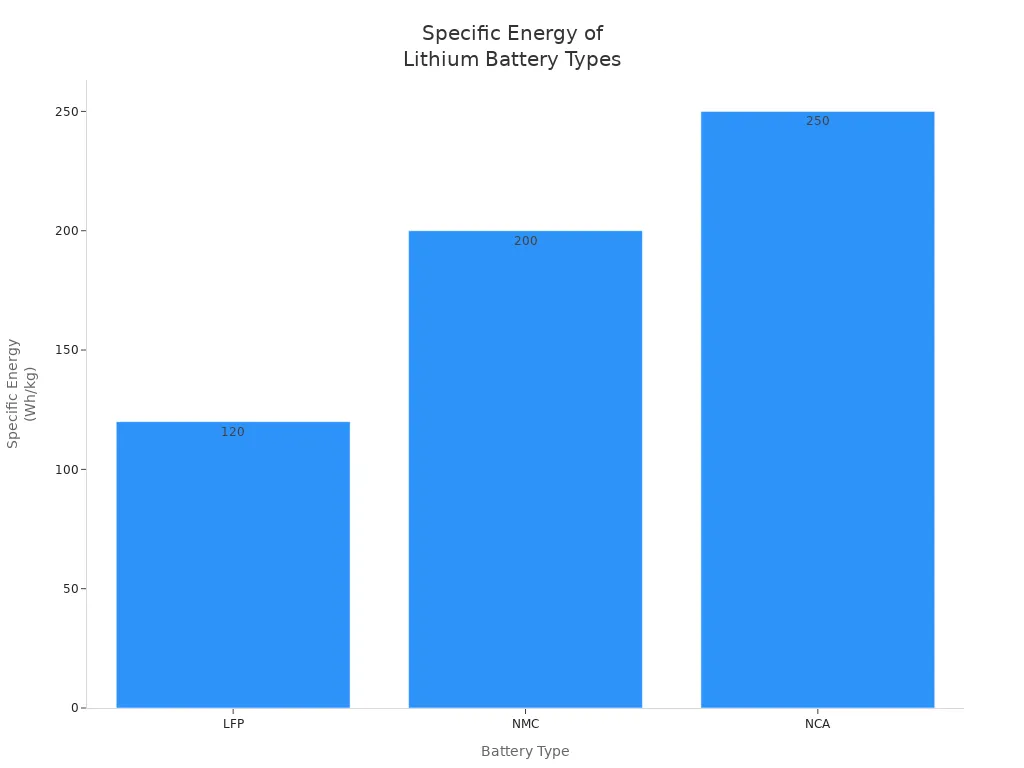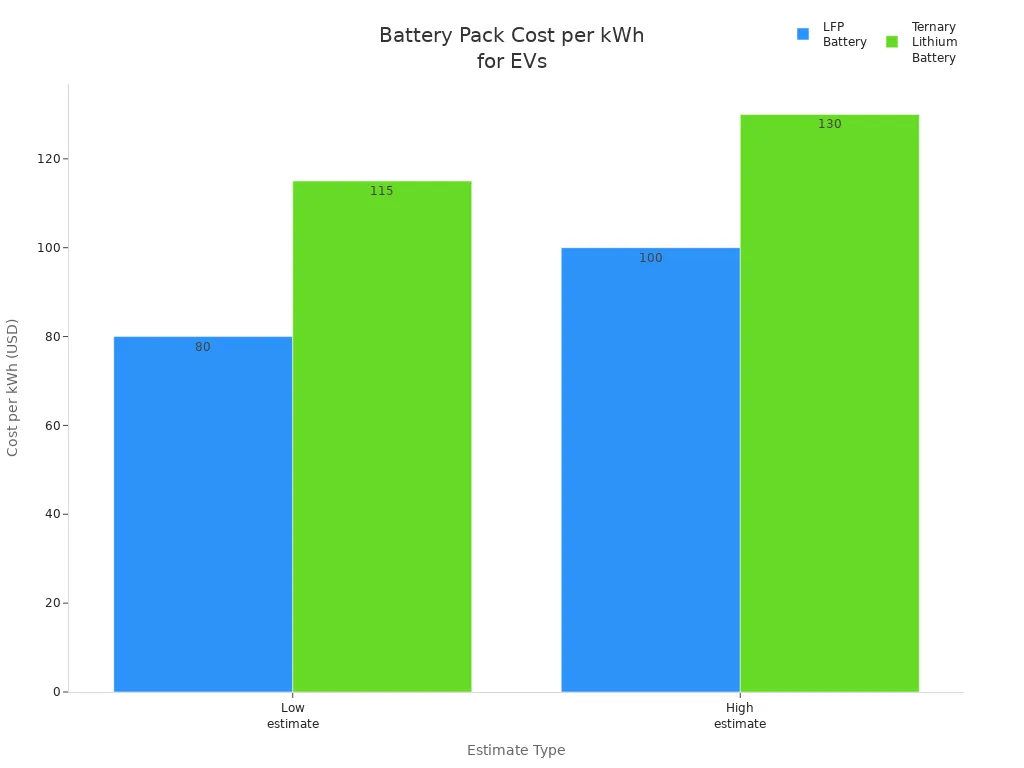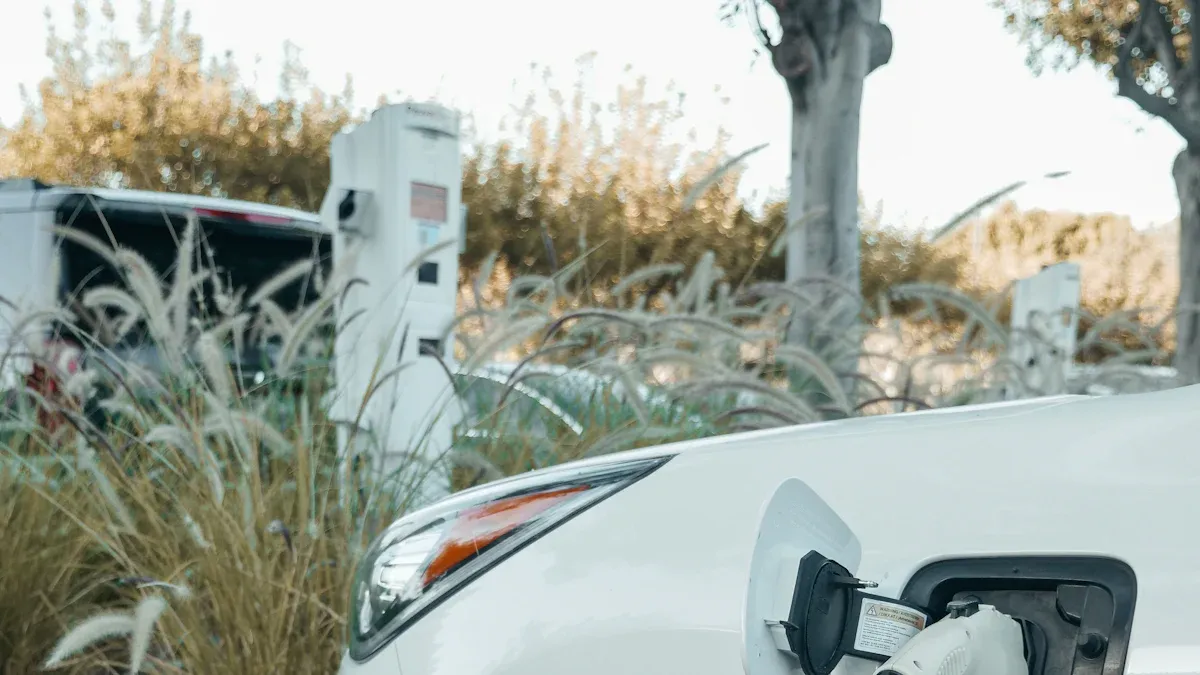
Choosing the right battery for an electric vehicle matters a lot. Many buyers look at lilo battery technology and ternary lithium batteries when shopping for EVs. Lilo battery technology, often called lfp, stands out for its strong safety and long cycle life. Ternary lithium batteries usually offer higher energy density, which means more driving range. Cost remains a top concern for most people, as nearly 60% see price as the biggest barrier. Lfp batteries often cost less and last longer. Charging speed, cold resistance, and environmental impact also help people decide. With so many factors, understanding each battery type helps buyers make the best choice.
Overview
LiLO-Batterie-Technologie
LiLO battery technology uses lithium iron phosphate as its main material. People often call these batteries LFP or lithium phosphate batteries. The lfp battery stands out for its safety and long cycle life. Many users choose lithium phosphate batteries because they do not catch fire easily. The lfp battery also works well for many charge and discharge cycles. This makes the lithium iron phosphate battery a good choice for those who want a reliable battery.
The lfp battery has a lower energy density than other types. This means it stores less energy for its size and weight. Most lfp batteries have a specific energy of about 120 Wh/kg. The high thermal stability of the lfp battery helps prevent overheating. Many smaller electric vehicles use lilo battery technology. Common uses include golf carts, forklifts, aerial work platforms, and e-bikes. Some boats and RVs also use lithium phosphate batteries. The lfp battery is popular in these areas because it lasts long and stays safe.
| Akku-Typ | Cathode Chemistry | Specific Energy (Wh/kg) | Thermische Stabilität | Safety and Cycle Life Characteristics |
|---|---|---|---|---|
| LFP | Lithium Iron Phosphate (FePO4) | ~120 | High thermal stability | Long cycle life, safer, lower specific energy |
| NMC | Nickel Manganese Cobalt Oxides | ~200 | Moderate thermal stability | Higher specific energy, more power, contains cobalt, higher safety risks |
| NCA | Nickel Cobalt Aluminum Oxides | Up to 250 | Lower thermal stability | Highest specific energy, long cycle life, contains cobalt, higher safety risks |

Ternary Lithium Batteries
Ternary lithium batteries use a mix of nickel, manganese, and cobalt for their cathode. These batteries include NMC and NCA types. The ternary lithium battery offers higher energy density than the lfp battery. Some ternary lithium batteries reach up to 250 Wh/kg. This means a ternary lithium battery can store more energy in the same space. Many electric cars use ternary lithium batteries because they give longer driving ranges.
The ternary lithium battery charges faster and works better in cold weather than the lfp battery. These batteries also power many consumer electronics and smart devices. The ternary lithium battery is common in electric vehicles, phones, and tools. People choose ternary lithium batteries when they want more energy and faster charging. However, the ternary lithium battery has more safety risks and uses rare metals like cobalt. This makes the ternary lithium battery more expensive and less stable than the lfp battery.
- Ternary lithium batteries are used in electric vehicles for longer range.
- Many consumer electronics use ternary lithium batteries for compact size and power.
- Energy storage systems and smart devices also use ternary lithium batteries.
- The ternary lithium battery is key for fast charging and cold resistance.
Wesentliche Unterschiede
Die Energiedichte
Energy density measures how much energy a battery can store for its weight. This factor affects how far an electric vehicle can travel on a single charge. Ternary lithium batteries offer a high energy density, which means they store more energy in a smaller space. Most ternary lithium batteries, such as NMC and NCA, have an energy density between 150 and 350 Wh/kg. In comparison, lithium phosphate batteries like LFP have an energy density between 90 and 160 Wh/kg. This difference explains why many automakers use ternary lithium batteries in vehicles that need longer range and higher performance.
| Akku-Typ | Energiedichte (Wh/kg) |
|---|---|
| Lithium-Eisen-Phosphat (LFP) | 90 – 160 |
| Ternary Lithium Batteries | 150 – 350 |
A higher energy density allows ternary lithium batteries to deliver more power and longer driving range. LFP batteries, while safer, provide less range for the same battery size. Drivers who need to travel long distances may prefer the high energy density of ternary lithium batteries.
Sicherheit
Safety remains a top concern for electric vehicle owners. LFP batteries stand out for their excellent safety record. The stable chemistry of lithium phosphate batteries makes them less likely to overheat or catch fire. LFP batteries resist thermal runaway, which means they stay safe even when damaged or exposed to high temperatures. Ternary lithium batteries, including NMC and NCA, have a higher risk of overheating and fire. Their chemistry contains nickel and cobalt, which can react strongly under stress.
Note: LFP batteries are often chosen for vehicles where safety is the highest priority, such as buses and family cars.
Ternary lithium batteries require advanced management systems to maintain safety. These systems monitor temperature and charging to prevent accidents. While ternary lithium batteries offer better performance, they need careful handling to ensure safety.
Kosten
Cost plays a big role in battery choice. LFP batteries cost less to produce than ternary lithium batteries. As of early 2025, manufacturers pay about $80-100 per kilowatt-hour for LFP battery packs. Ternary lithium battery packs, such as NMC and NCA, cost around $115-130 per kilowatt-hour. The lower cost of LFP batteries comes from their use of common materials like iron and phosphate. Ternary lithium batteries use nickel and cobalt, which are more expensive and harder to source.
LFP batteries also benefit from simpler supply chains and large-scale production. This trend helps lower their cost even more. For buyers who want an affordable electric vehicle, LFP batteries offer a strong value.
Zyklus Leben
Cycle life measures how many times a battery can charge and discharge before losing performance. LFP batteries have a long cycle life, often lasting over 2,000 cycles. This means lithium phosphate batteries can power a vehicle for many years without major loss of battery performance. Ternary lithium batteries usually last between 1,000 and 1,500 cycles. Their higher energy density comes at the cost of a shorter lifespan.
A long cycle life reduces the need for battery replacement, saving money and lowering environmental concerns. LFP batteries are a good choice for drivers who plan to keep their vehicles for a long time.
Aufladegeschwindigkeit
Charging speed affects how quickly a driver can get back on the road. Ternary lithium batteries charge faster than LFP batteries. Their chemistry allows for higher charging currents and better conductivity. Many ternary lithium batteries can reach 80% charge in less than 30 minutes with fast chargers. However, frequent fast charging can reduce battery performance and lifespan. Ternary lithium batteries need careful management to avoid overheating during charging.
| Aspekt | LFP (LiFePO4) Batteries | Ternary Lithium Batteries |
|---|---|---|
| Aufladegeschwindigkeit | Langsamere Ladegeschwindigkeiten | Schnellere Ladegeschwindigkeiten |
| User Convenience | Less convenient for rapid charging | More convenient for quick charging |
| Battery Durability | Highly durable, safer | Higher risk, needs management |
| Charging Infrastructure | Simpler, less demanding | Advanced, needs safety controls |
| Impact on Battery Life | Longer life, slower charging | Faster aging with frequent fast charging |
LFP batteries charge more slowly but handle repeated charging well. Their slower charging speed means less stress on the battery, which helps maintain a long cycle life. Drivers who need quick charging may prefer ternary lithium batteries, but they should avoid fast charging too often.
Kältebeständigkeit
Cold weather can affect battery performance and driving range. Ternary lithium batteries perform better in cold climates. They maintain higher discharge capacity and power output at low temperatures. For example, ternary lithium batteries can keep 70-90% of their capacity at -20°C. LFP batteries lose more capacity in the cold, dropping to 50-70% at the same temperature. This means electric vehicles with LFP batteries may see a bigger drop in range during winter.
- Ternary lithium batteries support better performance in cold weather, keeping EVs running longer.
- LFP batteries experience a larger drop in performance and range in cold conditions.
Drivers in cold regions may prefer ternary lithium batteries for reliable winter performance. LFP batteries, while safe, may not deliver enough power or range in freezing temperatures.
Auswirkungen auf die Umwelt
Environmental concerns shape battery choices for many buyers. LFP batteries use stable and abundant materials, which lowers their environmental impact during production. Their long cycle life also means fewer replacements and less waste. However, LFP batteries can have higher emissions during manufacturing due to resource use.
Ternary lithium batteries use nickel, manganese, and cobalt. These metals require complex mining and processing, which raises environmental concerns. Recycling helps reduce the impact, but proper handling is needed to avoid harm. Regulations require safe recycling and disposal of ternary lithium batteries to protect the environment.
| Aspekt | LFP Batteries (LiFePO4) | Ternary Lithium Batteries (NCM) |
|---|---|---|
| Production Environmental Impact | Higher resource use and emissions | Lower resource use, but more complex metals |
| Sicherheit | Stable, low risk | Less stable, higher risk |
| Die Energiedichte | Unter | Höher |
| Service Life | Länger | Kürzere |
| Recycling Methods | Hydrometallurgy, reduces environmental burden | Hydrometallurgy, reduces mineral scarcity |
| Environmental Burden Mitigation | Long life and clean energy use help offset impacts | Recycling and secondary use lower environmental costs |
LFP batteries offer a lower environmental impact over their lifetime due to safety and long lifespan. Ternary lithium batteries, while offering high energy density and performance, require careful recycling to address environmental concerns. Buyers who value sustainability may prefer lithium phosphate batteries for their lower environmental impact.
Anwendungen
Elektrisch betriebene Fahrzeuge
Electric vehicles rely on advanced battery technology to deliver safe, reliable, and efficient transportation. Most automakers select batteries based on energy density, safety, cost, and cycle life. Ternary lithium batteries, such as NMC and NCA, power many modern EVs. These batteries provide high energy density, which allows vehicles to travel longer distances on a single charge. Drivers benefit from fast charging and strong acceleration, making ternary lithium batteries ideal for passenger cars and high power applications.
LiFePO4 (LFP) batteries also play a key role in the EV market. Many manufacturers use LFP batteries in entry-level models and commercial vehicles. These batteries offer excellent safety, long cycle life, and lower cost. LFP batteries perform well in high-temperature environments and resist overheating. Automotive experts highlight that LFP batteries have higher thermal stability and fewer hazardous byproducts, making them a safer choice for family cars and buses.
| Aspekt | LiFePO4 (LFP) Batteries | Ternary Lithium Batteries |
|---|---|---|
| Sicherheit | Higher thermal stability; lower risk of overheating/fire | Higher risk of overheating and fire |
| Die Energiedichte | Lower (100–120 Wh/kg), bulkier and heavier | Higher (160–180 Wh/kg), more compact and lighter |
| Zyklus Leben | Longer lifespan; thousands of cycles | Long lifespan but generally shorter than LFP |
| Kosten | Generally lower cost | Higher cost |
| Auswirkungen auf die Umwelt | Easier to recycle; fewer hazardous byproducts | Contains toxic cobalt; environmental concerns |
Other Uses
Batteries serve many applications beyond electric vehicles. LFP batteries lead in non-automotive fields because of their safety, stability, and long lifespan. These batteries power data centers, server room systems, communication base stations, and emergency power supplies. Industrial applications, such as forklifts and medical equipment, also use LFP batteries for their reliability. The energy storage market stands out as the largest application for LFP batteries. Energy storage systems use these batteries to support grid services, peak shaving, and frequency modulation.
Ternary lithium batteries appear less often in non-automotive applications. Their main advantage lies in passenger cars, where compact size and high energy density matter most. In contrast, LFP batteries dominate stationary energy storage because weight and size are less critical, and safety is a top priority.
Tip: When choosing a battery for any application, consider the specific needs—such as safety, lifespan, and performance—to match the right technology to the job.
Die Wahl der richtigen Batterie
Daily Driving
For city drivers, the choice of battery affects daily applications and convenience. LiFePO4 (LFP) batteries work well for short commutes and frequent stops. These batteries offer high safety, long cycle life, and simple maintenance. Their lower energy density suits city driving, where range demands stay moderate. Ternary lithium batteries provide more range but cost more and need careful management. The table below compares key factors for daily driving:
| Faktor | LiFePO4 (LFP) Battery | Ternäre Lithium-Batterie |
|---|---|---|
| Die Energiedichte | Lower (100-150 Wh/kg), suitable for city driving | Higher (150-200 Wh/kg), longer driving range |
| Price | Lower cost, more affordable | Higher cost, more expensive |
| Zyklus Leben | Longer (2000-3000+ cycles), better longevity | Shorter (500-1000 cycles) |
| Sicherheit | High safety, stable structure, less risk of thermal runaway | Lower safety, prone to thermal runaway and fires |
| Kältebeständigkeit | Poor cold performance, reduced capacity in low temps | Better cold resistance, maintains performance in cold |
| Aufladegeschwindigkeit | Slower charging (1-2 hours for 80%) | Faster charging (up to 80% in 30 minutes) |
| Wartung | Simpler battery management, lower maintenance | More complex management required |
| Anmeldung | Best for city/commuter EVs, budget-conscious buyers | Suitable for high-performance, long-range EVs |
Long-Distance Travel
Drivers who travel long distances need batteries with high energy density and fast charging. Ternary lithium batteries deliver longer range and better battery performance on highways. These batteries also charge quickly, making them ideal for road trips. LFP batteries, while safe and durable, offer shorter range and slower charging. This can limit their applications for frequent long trips. Both battery types work with public charging stations, but ternary lithium batteries use fast chargers more efficiently.
| Merkmal | Ternäre Lithium-Batterie | LiLO (LFP) Akku |
|---|---|---|
| Die Energiedichte | Higher energy density, enabling longer driving range | Lower energy density, resulting in shorter driving range |
| Aufladegeschwindigkeit | Faster charging, can reach 80% charge in about 30 minutes | Slower charging, typically 1-2 hours for 80% charge |
| Kältebeständigkeit | Better performance and capacity retention in cold temperatures | Performance and capacity significantly decrease in cold, reducing range |
| Charging Infrastructure Compatibility | Compatible with existing infrastructure; faster charging better leverages high-power chargers | Compatible with existing infrastructure but slower charging limits use of fast chargers |
| Safety and Durability | Relatively lower safety, higher cost | High safety, longer cycle life, more durable |
Budget Needs
Cost remains a top concern for many buyers. LFP batteries use affordable materials and simple production methods. This lowers the price of electric vehicles by $3,000 to $7,000 compared to models with ternary lithium batteries. Ternary lithium batteries cost more because they use expensive metals and complex manufacturing. For budget-conscious buyers, LFP batteries make electric vehicles more accessible.

Climate Considerations
Climate affects battery performance and lifespan. LFP batteries excel in hot climates because of their thermal stability and safety. These batteries resist overheating and last longer in high temperatures. Ternary lithium batteries perform better in cold weather, keeping more capacity and power during winter. Drivers in cold regions may prefer ternary lithium batteries for reliable applications and range. Those in hot areas benefit from the safety and durability of LFP batteries.
| Merkmal | Ternäre Lithium-Batterie | LFP Battery |
|---|---|---|
| Kältebeständigkeit | Performs better in cold weather | Less effective in cold weather |
| Sicherheit | Lower compared to LFP | Excellent thermal stability and safety |
| Zyklus Leben | Kürzere | Länger |
| Die Energiedichte | Höher | Unter |
| Aufladegeschwindigkeit | Faster | Slower |
Tip: Drivers should match their battery choice to their main applications, travel habits, and local climate for the best performance and value.
Comparison Table
Choosing the right battery for an electric vehicle means looking at many important factors. The table below shows how lfp batteries and ternary lithium batteries compare in areas that matter most to drivers. These include energy density, safety, cost, cycle life, charging speed, cold resistance, and environmental impact. Each battery type has strengths and weaknesses that affect daily use, long trips, and overall performance.
| Faktor | LFP Batteries (LiLO) | Ternary Lithium Batteries |
|---|---|---|
| Die Energiedichte | Lower energy density, shorter driving range | High energy density, longer driving range |
| Sicherheit | High safety, stable, low risk of fire or explosion | Lower safety, higher risk of thermal runaway |
| Kosten | Lower cost, uses cheaper materials | Higher cost, uses expensive metals |
| Zyklus Leben | Longer cycle life (2000-3000+ cycles) | Shorter cycle life (500-1000 cycles) |
| Aufladegeschwindigkeit | Slower charging (1-2 hours to 80%) | Faster charging (up to 80% in 30 minutes) |
| Kältebeständigkeit | Weaker performance in cold, range drops more | Better performance in cold, keeps more power |
| Auswirkungen auf die Umwelt | Lower impact, easier recycling, safer for environment | Higher impact, uses rare metals, harder to recycle |
| Power | Lower power density, good for standard EVs | Higher power, better for high-performance EVs |
| Wartung | Simpler battery management, less maintenance | More complex management, needs careful handling |
Tip: LFP batteries give drivers peace of mind with strong safety and long life. Ternary lithium batteries offer more power and range, but drivers must watch for higher cost and safety risks.
- LFP batteries work best for city driving, daily commutes, and hot climates.
- Ternary lithium batteries fit high-performance cars and cold regions where charging speed and range matter most.
Drivers should match their battery choice to their needs. Safety, cost, and performance all play a role in finding the best fit.
Future Trends

Battery technology for electric vehicles continues to change quickly. Researchers and engineers work hard to make both LFP and ternary lithium batteries better. They focus on making batteries safer, more powerful, and longer lasting.
Ternary lithium batteries show great promise for the future. Scientists use advanced materials science to improve these batteries. They add lighter components and new electrolyte formulas. Cathode additives and special polymer binders help increase energy density and safety. These changes allow batteries to store more energy and charge faster. As a result, electric vehicles can travel farther and recharge in less time. Many experts believe that these improvements will make ternary lithium batteries more common in high-performance and long-range cars.
LFP batteries also see important progress. Manufacturers choose LFP batteries for their safety, long cycle life, and low cost. These batteries work well in city cars and mainstream electric vehicles. New research aims to boost their energy density and charging speed. Better recycling methods help reduce waste and protect the environment. Companies look for ways to make LFP batteries even more affordable and reliable.
Battery makers now focus on both performance and sustainability. They want to use fewer rare metals and create batteries that last longer and are easier to recycle.
The table below shows how LFP and ternary lithium batteries compare as technology advances:
| Merkmal | LFP Battery Characteristics | Merkmale der ternären Lithiumbatterie |
|---|---|---|
| Die Energiedichte | Lower, but improving for city EVs | Higher, with ongoing gains for long-range EVs |
| Sicherheit | High thermal stability, safer | Lower thermal stability, but new materials improve safety |
| Zyklus Leben | Long, durable | Shorter, but research aims to extend lifespan |
| Aufladegeschwindigkeit | Slower, but getting faster | Fast, with further improvements expected |
| Kältebeständigkeit | Good, especially for moderate climates | Improving, but still a challenge in extreme cold |
| Kosten | Affordable, with potential for further reduction | Higher, but new methods may lower costs |
| Auswirkungen auf die Umwelt | Lower, with better recycling | Higher, but recycling efforts are increasing |
In the coming years, drivers can expect safer, more efficient, and greener batteries. The future of electric vehicles looks bright as battery technology keeps moving forward.
Choosing between LFP and ternary lithium batteries depends on what drivers need most. LFP batteries offer strong safety, long life, and lower cost. Ternary lithium batteries give more range, faster charging, and better cold performance. Buyers should look at how they drive, their budget, and the climate where they live. Some batteries work best for city trips, while others fit long journeys. Each battery type brings unique strengths. Careful comparison helps buyers select the right batteries for their electric vehicles.
FAQ
What is the main difference between LiLO (LFP) and ternary lithium batteries?
LiLO (LFP) batteries use lithium iron phosphate. Ternary lithium batteries use nickel, manganese, and cobalt. LFP batteries offer more safety and longer life. Ternary lithium batteries provide higher energy density and faster charging.
Which battery lasts longer in electric vehicles?
LFP batteries usually last longer. They can handle over 2,000 charge cycles. Ternary lithium batteries often last between 1,000 and 1,500 cycles. Drivers who want a battery for many years may prefer LFP.
Are LFP batteries safer than ternary lithium batteries?
Yes. LFP batteries have stable chemistry. They resist overheating and fire. Ternary lithium batteries need careful management to stay safe. Many experts recommend LFP for family cars and buses.
Do LFP batteries work well in cold weather?
LFP batteries lose more capacity in cold weather. Ternary lithium batteries keep more power in low temperatures. Drivers in cold regions may see better winter performance with ternary lithium batteries.
Which battery is better for budget-conscious buyers?
LFP batteries cost less. They use cheaper materials and simpler production. Many affordable electric vehicles use LFP batteries. Ternary lithium batteries cost more because they use rare metals.
Tip: Always check your local climate and driving needs before choosing a battery.

